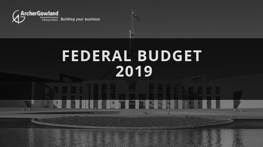
The Australian Federal Budget has now been delivered and the Opposition has responded.
Last Tuesday, the Federal Treasurer Mr Josh Frydenberg handed down the 2019-20 Federal Budget announcing a surplus of $7.1 billion – a first in 12 years – returning Australia ‘back on track’, “restoring the nation’s finances” and bringing the Budget “back in the black”.
The Budget outlined the Government’s investment in Infrastructure, providing stronger tax relief & benefits to the Individual tax payer, Low & Middle Income Earners, and Small/Medium Sized Business, as well as providing older Australians with a greater opportunity to prepare for retirement.
As we wait the Government’s call for an Election (which is assumed to be a 18th May 2019 date for voting), the release of the Budget acts as a precursor to policies for the Australian people to decide upon prior to voting.
Whilst some of the measures will not be enacted for some time, others have been quickly passed through Parliament over the course of the week.
We breakdown the main measures released as follows below:
Income Tax
Personal Income Tax
- Low and Middle Income Tax Offset
The Government will extend the Low and Middle Income Tax Offset (LMITO) by increasing the base amount from $200 to $225 per year and the maximum amount from $530 to $1,080 per year.
Taxpayers with income between $48,000 and $90,000 will be eligible to receive the maximum offset of $1,080. The offset phases out with incomes up to $126,000.
The offset will apply to tax returns lodged from 1 July 2019.
The Low and Middle Income Tax Offset is due to end on 30 June 2022.
- Proposed Marginal Tax Rate & Thresholds
The new marginal tax rates and thresholds proposed by the Government are as follows:
| Tax Rates | 2018-22 | 2022-24 |
| Nil | Up to $18,200 | Up to $18,200 |
| 19% | $18,201 - $37,000 | $18,201 - $45,000 |
| 32.5% | $37,001 - $90,000 | $45,001 - $120,000 |
| 37% | $90,001 - $180,000 | $120,001 - $180,000 |
| 45% | Above $180,000 | Above $180,000 |
Increasing the Medicare Levy low-income thresholds
Effective from 1 July 2018, the Government will increase the Medicare Levy low-income thresholds for singles, families, and seniors and pensioners from the 2018-19 income year.
The following table compares the level of taxable income below, which no Medicare Levy is payable:
| Income Category | 2017-18 | 2018-19 |
| Taxpayers entitled to seniors and pensioners tax offset (SAPTO) | ||
| Individual | $34,758 | $35,418 |
| Married or Sole Parent | $48,385 | $49,304 |
| For each dependent child or student, add: | $3,406 | $3,471 |
| All other tax payers | ||
| Individuals | $21,980 | $22,398 |
| Couple/Sole Parent (family income) | $37,089 | $37,794 |
Instant Asset Write-Off
On Wednesday, 3rd April 2019, the Governments' proposed Bill to increase & expand the Instant Asset Write-Off for Small and Medium-Sized business was passed through the Senate.
The following outlined the proposals, which have now taken effect:
- The instant asset write-off threshold for small businesses (aggregated turnover of less than $10 million) has been increased to $30,000 for eligible assets that are first used or installed to use until 30 June 2020.
- Small business will be able to immediately deduct purchases of assets costing less than $25,000.
- Medium-sized businesses - less than $50 million aggregated turnover - will be able to immediately deduct purchases of eligible assets costing less than $30,000 that are first used or installed to use until 30 June 2020.
The able below shows the changes made in the Instant Asset Write-Off:
| Asset first used or installed ready for us between | Small Business (turnover less than $10 million) | Medium Business (turnover less than $50 million) |
| 1 July 2018 to 28 January 2019 | < $20,000 | N/A |
| 29 January 2019 to Budget night | < $25,000 | N/A |
| Budget night to 30 June 2020 | < $30,000 | < $30,000 |
Income tax exemption for North Queensland flood grants
An income tax exemption will be provided for qualifying grants made to primary producers, small businesses, and non-profit organisations affected by the North Queensland floods.
Qualifying grants include Category C and Category D grants provided under the Disaster Recovery Funding Arrangements 2018, grants provided under the On-Farm Restocking and Replanting Grants Program and the On-Farm Infrastructure Grants Program.
The exemption will apply where the grants relate to the monsoonal trough, which produced flooding that started on or after 25 January 2019 and continued into February 2019. The grants will be made non-assessable non-exempt income for tax purposes.
Superannuation
Acceptance of superannuation contributions allowed for 65 and 66-year olds
Members of regulated superannuation funds have zero restrictions for making voluntary contributions prior to reaching 65 years of age. From 1 July 2020, the Government intends to increase this age limit and allow 65 and 66-year olds to contribute.
The changes to the contribution rules apply to both concessional and non-concessional contributions. As no restriction will apply for 65 and 66-year olds, this also means the three-year “bring forward” contributions will be allowed. Therefore, more members will be entitled to make up to three years non-concessional contributions in one financial year.
Spouse contribution tax offset eligibility extended
Restrictions relating to an individual claiming a spouse contribution tax offset are proposed to be reduced from 1 July 2020. The easing of the rules is by giving spouses aged 70 to 74 eligibility if they meet the work test. Also, in line with other budget measures, spouses aged 65 and 66 will not need to meet the work test at all.
Although eligibility criteria has been extended for some spouses, there is no change announced to the:
- amount of the offset
- income limits of the spouse
- restrictions relating to the spouse's contribution caps
- Non-refundable attribute of the offset itself
Aged Care
Access to Aged care
The Government will provide $320 million for a one-off increase to the basic subsidy for residential aged care recipients. $35.7 million will be provided to increase dementia and veterans’ home care supplements to support home care recipients who require additional care to stay in their homes longer.
The Government will provide $4.6 million to trial a residential care needs assessment funding tool as an alternative to the existing Aged Care Funding Instrument.
$7.1 million will be provided over two years to improve payment administration arrangements for home care packages to align home care arrangements with other Government programs, such as the National Disability Insurance Scheme.
Home Care Packages
The Government’s Home Care Packages Program supports Australians who choose to receive care in their own homes. The Government is providing $282.4 million over five years from 2018-19 for an additional 10,000 home care packages across all levels.
Australians with dementia or requiring cognition support will benefit from additional funding for home care supplements, and the Government is providing $7.7 million to develop an end-to-end compliance framework for home care.
Other Measures Announced
Requirements for ABN holders to retain their status
To disrupt black economy behaviour, Australian Business Number (ABN) holders:
- with an income tax obligation will be required to lodge their income tax return, from 1 July 2021.
- will be required to confirm the accuracy of their details on the Australian Business Register annually, from 1 July 2022.
Income from forced sale of livestock invested into farm management deposit
From 1 July 2019, net income generated from the forced sale of livestock will be exempted from Farm Household Allowance (FHA) payment assessment, when that income is invested into a farm management deposit.
The measure is to ensure that FHA recipients who are destocking retain access to income support and are able to make long-term financial plans for their future.
More Information
For more information on how the Budget will impact you, your family, or organisation, please contact Ian Walker at Archer Gowland on (07) 3002 2699.
%20-%20HubSpot%20(1).png)
